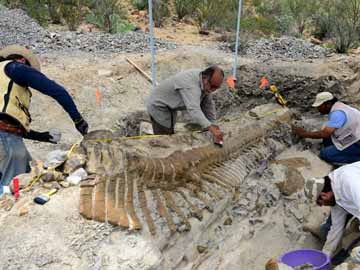After 20 days of working in the desert of Coahuila, within the Ejido Guadalupe Alamitos, municipality of General Cepeda, paleontologists from the National Institute of Anthropology and History (INAH) and the National Autonomous University of Mexico (UNAM), with support from the local council , 50 vertebrae recovered the only complete articulated dinosaur tail so far been discovered in Mexico.
Very slowly to not break what nature remained unchanged for 72 million years, paleontologists removed sedimentary rock covering the vertebrae of the animal and discovered the skeleton of a hadrosaur long tail that reaches five meters, the 50 vertebrae excavated remain bound together as when the dinosaur inhabited the planet.
For biological studies it is known that the type of dinosaur to which the specimen had between 50 and 70 caudal vertebrae. Besides the tail skeleton, within 20 days of the excavation carrying long bones were recovered and hip. The characteristics of the caudal vertebrae and sacral has helped to identify that it is a hadrosaur or duckbill Crested-named scientifically as lambeosaurine -, but still can not specify the species because they need to find more bones.
This was informed by the paleontologist INAH-Coahuila Center, Felisa Aguilar, who directed the excavation along with his colleague René Hernández UNAM, the specialist explained that the tail is half skeleton, which means that practically Articulated retained average hadrosaurio body part, whose total length is calculated 12 meters.
He noted that the recovery of this skeleton is of great importance for the Mexican paleontology because it is very rare to find this type of specimens with most of his bones together.
“For the biological study of dinosaurs this finding is important because we will have a sequence that will reveal the characteristics of the vertebrae. How they will be seen differentiating in size depending on their position in the spine, “said science teacher Angel Ramirez Velasco, paleontologists team member of this project.
He further stressed that “shows the space where was the cartilage between vertebrae, which would help biomechanical studies of the tail.”
Also, Felisa Aguilar stressed that the excavation site found elsewhere in the skeleton, among them the bones of the extremities, and think that under the tail is the rest of the specimen.
Reiterated that Mexico is the first time that a tail is articulated, whereas in other parts of the world have been found infrequently. The skeleton was found by José López and Rodolfo Espinoza, in early May 2005. In June 2012 it was reported to INAH, and after an inspection to verify the finding was elaborated the bailout bill, the same that started after being approved by the Council of the Institute of Archaeology.
The rescue was carried out with support from the municipal government of General Cepeda, through the mayor Jose Guadalupe Sanchez Rangel, who gave council a space laboratory to condition where the skeleton will move in the coming weeks.
Excavation Techniques
The paleontologist Felisa Aguilar explained that the field season to regain hadrosaur skeleton began on July 2, it is a rescue that has required great care not to lose the articulation of the bones, so it is a technique that paleontology is known as “quarry”.
This procedure involves removing the sedimentary rock fossils along a horizontal plane of layers, in addition, while the materials are released revises the context: the orientation of the fossils and the type of sediment that makes up each layer that surrounds the remains digging.
Aguilar explained that the rescue started by cleaning the surface and setting the excavation grid. “We originally thought our work area would be 3 by 6 meters, but as it was releasing the skeleton was the need to extend down to the 4 by 8 feet, following the guidance of the skeletal remains.”
“Before removing the bones, clean the surface to see how far the joint, and as I was leaving the material decided how to continue digging,” said Aguilar.
Also, he added, were made photographic records, drawing and video of the whole process to keep any details of the joint, so that before removing the bones pull a mold and develop a carbon copy of the way the body when to die, that for purposes of research and education.
The paleontologist said that it is necessary to analyze the type of environment in which they found the hadrosaur, and review each material to rule out any natural event as the cause of his death, but by the characteristics analyzed so far consider that died of natural causes.
The hadrosaur was found in the municipality of General Cepeda, 15 kilometers from the site The Eagles and 20 miles of Rincon Colorado, which are the most important paleontological sites in Coahuila, which will complement the distribution map of the dinosaurs.
He noted that for conservation reasons it is impossible not hadrosaur tail in the place where it was found. He will move to the county seat, to be conditioned space as a laboratory to clean, consolidate and make the identification of each bone, which will determine the kind of question. The specimen will be taken in parts, to avoid any breakage, and in the laboratory, after cleaning and consolidation, will be re-assemble.
Note that the laboratory is left open for people from nearby towns know the process of preparation, preservation and identification.
Also involved in the rescue the biologist José Luis Gudino, graduate student of M. in C. Rene Hernandez, Jose Lopez Espinoza and the artist Marisol Lara, partners Paleontology Section Coahuila INAH Center. Read original article in Spanish here: http://www.inah.gob.mx/boletines/17-arqueologia/6676-avanza-rescate-de-cola-de-dinosaurio-en-coahuila

